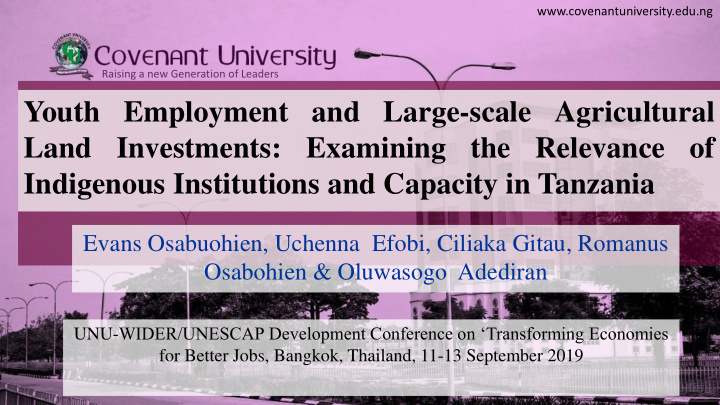



www.covenantuniversity.edu.ng Raising a new Generation of Leaders Youth Employment and Large-scale Agricultural Land Investments: Examining the Relevance of Indigenous Institutions and Capacity in Tanzania Evans Osabuohien, Uchenna Efobi, Ciliaka Gitau, Romanus Osabohien & Oluwasogo Adediran UNU- WIDER/UNESCAP Development Conference on ‘Transforming Economies for Better Jobs, Bangkok, Thailand, 11-13 September 2019
Outline • Introduction • Why Tanzania? • Key Research questions • Conceptual framework • Data and methods of analysis • Results & discussion • Conclusion & agenda for future research 2 www.covenantuniversity.edu.ng
Introduction (1) ◆ Issues on youth and (un)employment in Africa. o The ratio of youth to adult unemployment rate in Africa is about 2.5 o youth account for 60% of all joblessness in the continent. o Africa is one of the most youthful regions of the world. o Africa’s youth population expected to be one quarter of the world’s young people by 2025 (World Bank, 2018). 3 www.covenantuniversity.edu.ng
Introduction (2) ◆ Initiatives to make agricultural sector more attractive for the youth & create jobs (e.g. AU’s African Youth Charter). o Large-scale agricultural land investments (LALIs) in Africa higher than other regions of the world. o Varied arguments on the implications of LALIs. ➢ Thus, we extend the frontiers on LALIs by using Tanzania’s evidence to underscore that LALIs may not translate to youth employment – without an effective institutional framework & capacity especially at the local level. 4 www.covenantuniversity.edu.ng
Why Tanzania? (1) • Tanzania is in East Africa. • Has vast areas & parks (‘big 5 ’ game: elephant, lion, leopard, buffalo & rhino); • Kilimanjaro, Africa’s highest mountain. • Over 57 million people 5 www.covenantuniversity.edu.ng
Why Tanzania? (2) • Among top 20 destinations of global LALIs & top 10 in Africa. • Covered by LSMS_ISA • Agriculture employs about 70% of labour force • One of world’s fast growing population with increasing number as youth 6 www.covenantuniversity.edu.ng
Key Research Questions ① What is the influence of LALIs on youth employment (YE)? ② How does YE in communities with LALIs differ from those in communities without LALIs? ③ How can indigenous institutions interact with LALIs occurrence to influence YE? ④ In what ways do local capacity influence YE given LALIs occurrence? 7 www.covenantuniversity.edu.ng
Conceptual Framework 8 www.covenantuniversity.edu.ng
Data • Living Standard Measurement Study – Integrated Surveys on Agriculture (LSMS – ISA). • LSMS – ISA: HHs, communities & agriculture • Conducted 2008/09, 2010/11 & 2012/13 (2014/15 – New) • About 3924 households. • About 10000 individuals • Info on communities with LALIs from Land Matrix Global Observatory data. 9 www.covenantuniversity.edu.ng
Some Clarifications • Youth • ILO: individuals within 15-24years. • AU: 16 • Youth employment (YE): individuals within 15-24years engaged in an economic activity with incentive in the form of economic values. • The opposite is ‘youth unemployment’ (YU) 10 www.covenantuniversity.edu.ng
Empirical Model • We extend Asiedu et al (2011); Osabuohien (2014; 2019). • The empirical model is surmised as: 11 www.covenantuniversity.edu.ng
Empirical Results ① Descriptive ② Econometric 12 www.covenantuniversity.edu.ng
Table 1: Summary Statistics of Key Variables 13 www.covenantuniversity.edu.ng
Some Regression Results (1) 14 www.covenantuniversity.edu.ng
Some Regression Results (2) 15 www.covenantuniversity.edu.ng
Some Regression Results (3) 16 www.covenantuniversity.edu.ng
Some Robustness checks o Only Rural areas (Table 8) o the signs of the variables remained consistent. o Regression using Tobit Technique (Table 9) o suitable for estimating models with truncated explained variable. o explained variable is between two alternatives: worked for pay (right censored) or not (left censored). o Results remained consistent. 17 www.covenantuniversity.edu.ng
Summary of Main Findings & Implications 1. Indigenous Institutions & capacity: community tribunals, the social stability; education of community leaders, are important factors that can enhance the LALIs’ effect on youth employment in Tanzania 2. Implication: ✓ strengthening & ensuring functional NSAs ✓ social stability & security be encouraged ✓ leadership capacity in the host community be enhanced 18 www.covenantuniversity.edu.ng
Conclusion & Future Research ◆ Future research to complement: o Comparative analysis on implication of LALIs on employment (e.g. Tanzania & other African countries with LALIs) o Fieldwork and mixed method (qualitative and quantitative) 19 www.covenantuniversity.edu.ng
www.covenantuniversity.edu.ng Raising a new Generation of Leaders Thanks for your attention (pecos4eva@gmail.com; evans.osabuohien@covenantuniversity.edu.ng)
Recommend
More recommend